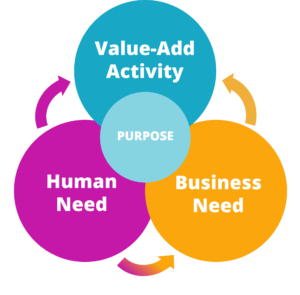Recently, one of the Directors of QHr (let’s call him Rob) posted a social media observation about Apple requiring their teams to return to the workplace ‘initially’ for one (1) day per week.
The response to this ranged from passionate agreement on the need to be physically present – through to resigning unless hybrid work meant never physically returning to the workplace (literally).
No matter the side you take in this discussion, we thought we’d unpack some of the issues and explain why you should still be thinking about this now.
What is Hybrid Working?
A simple explanation is:
a ‘model’ of ways you offer for people to manage their work-life balance goals and meet their business tasks-goals at the same time.
NB: The impact of COVID-19 has underscored the order of these two goals in our QHr Model…
It might mean:
- Working 100% from home.
- Using technology more effectively to shorten the working week.
- Working 2 days from home and 3 days from the office.
- Recognising travel to work as part of the working day (if it can be productive).
- Working from a close-by company satellite office and, twice a month, returning to a Head Office for a team meeting.
- Working 7.6 hours spread between 6am to 6pm.
NB: these are just a few examples and, we recognise, are likely dependent on your industry and the type of work your team does.
Is it a legal right?
Hybrid work is not a legislated requirement for Australian businesses.
However…… the forerunner in Australia is the concept of ‘flexible work’.
Many Australian workplaces already have the provision to request Flexible Working Arrangements (FWA) – which form part of the National Employment Standards (NES).
Although they are potentially not as expansive as a Hybrid Work Model, they nonetheless allow for ‘some’ ‘Human Need options’ to be agreed (where eligibility requirements are met).
NB: FWA can be initiated by a team member and (legally) require a business to respond with reasons for granting or refusing the request.
People vs Business Needs
Another concept to consider as you weigh up establishing your own Hybrid Work Model is how Human and Business Needs might be met by your proposed model (this is the ‘Value-Add Activity’ in the diagram below).

‘Just because one of the parties wants hybrid working doesn’t automatically make it a priority for the other.’
(as controversial as that may sound).
Let’s consider this concept via a company struggling to find people in a tight labour market (*ahem* such as right now).
This is their Business Need.
They might identify that a Hybrid Work Model will provide better engagement and life balance for teams (Human Need) which in turn increases job applications and lowers the costs of future hiring / turnover impacts for the business (possibly, and eventually, removing their Business Need).
Which leads us to a final thought…
Employee Value Proposition (EVP)
One of the biggest impacts we feel a Hybrid Work Model can make is to your Employee Value Proposition (EVP) [subject to your industry and roles].
Think of your EVP as not only the financial and non-financial rewards you offer but the way your company goes about doing business that is unique to others.
This ‘uniqueness’ is why your Customers, and your Teams, join and stay with you.
We will cover EVP’s in future articles – but will safely guess that at least one of your competitors is already thinking how hybrid work might form part of their unique offering and be the reason people join and stay with them.
What to do?
‘Great companies’ (to coin Jim Collins) are likely already considering the advantages a Hybrid Work Model might bring to them in a post-pandemic world.
Some thoughts we help Clients ponder when considering this question include:
- Consider your Business needs / Mission for the next 18 – 36 months?
- Does a Hybrid Work Model help or hinder?
- What adjustments would need to be made?
- Are adjustments realistic, achievable, and cost effective?
- What do you have to give up to implement the Model?
- How will you measure success?
- And the most important part… if you feel a Hybrid Work Model is part of your Mission, ask your team what is important to them BEFORE implementing one and compare that to your answers above.
HINT:
How you plan a Hybrid Work Model for a team who may want even more might be an indicator of a misalignment in each parties Purpose/Values/Vision/Mission.
#robservation
And if it’s all still confusing?
If you need help or have a sense this might be a future issue for your business, please click the link below and we’ll be happy to speak to you about any ideas this article has raised for you (or your team).
Thanks for reading!

